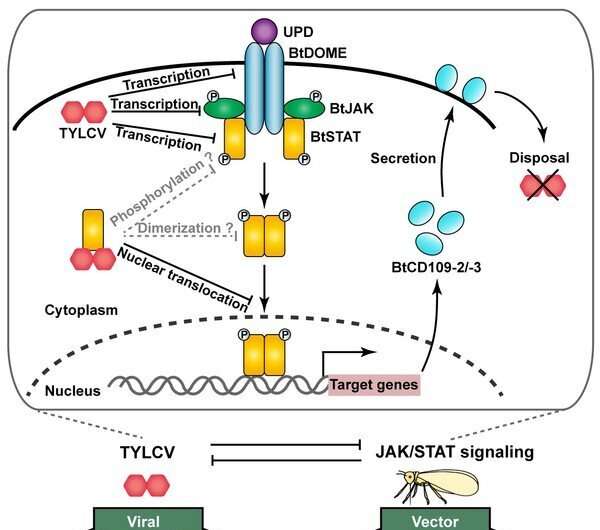Scientists discover molecular mechanisms for virus-vector co-evolution

On October 3, the team led by Prof. Wang Xiaowei at the Zhejiang University College of Agriculture and Biotechnology published a research article entitled "A balance between vector survival and virus transmission is achieved through JAK/STAT signaling inhibition by a plant virus" in the Proceedings of the National Academy of Sciences.
Viruses constitute a tremendous threat to crops, with many being dependent on insect vectors for transmission between hosts. While the virus–host race has been well established, how viruses and insect vectors adapt to each other remains poorly understood. A detailed analysis of the molecular mechanisms will improve our understanding of virus–vector co-evolution.
Begomoviruses comprise the largest genus of plant-infecting DNA viruses and are exclusively transmitted by the whitefly Bemisia tabaci. The authors showed that the vector Janus kinase/signal transducer and activator of transcription (JAK/STAT) pathway plays a crucial role in mediating adaptations between the begomovirus tomato yellow leaf curl virus (TYLCV) and whiteflies.
They found that the JAK/STAT pathway in B. tabaci functions as an antiviral mechanism against TYLCV infection in whiteflies as evidenced by the increase in viral DNA and coat protein (CP) levels after inhibiting JAK/STAT signaling. Two STAT-activated effector genes, BtCD109-2 and BtCD109-3, mediate this anti-TYLCV activity. To counteract this vector immunity, TYLCV has evolved strategies that impair the whitefly JAK/STAT pathway.
Infection of TYLCV is associated with a reduction of JAK/STAT pathway activity in whiteflies. Moreover, TYLCV CP binds to STAT and blocks its nuclear translocation, thus putting an end to the STAT-dependent transactivation of target genes.
The study also demonstrated that inhibition of the whitefly JAK/STAT pathway facilitates TYLCV transmission but reduces whitefly survival and fecundity, indicating that this JAK/STAT-dependent TYLCV–whitefly interaction plays an essential role in striking a balance between whitefly fitness and TYLCV transmission.
This study sheds light on the virus–vector arms race and provides insights into how viruses and vectors can coexist with each other.
More information: Yu-Meng Wang et al, A balance between vector survival and virus transmission is achieved through JAK/STAT signaling inhibition by a plant virus, Proceedings of the National Academy of Sciences (2022). DOI: 10.1073/pnas.2122099119
Journal information: Proceedings of the National Academy of Sciences
Provided by Zhejiang University



















